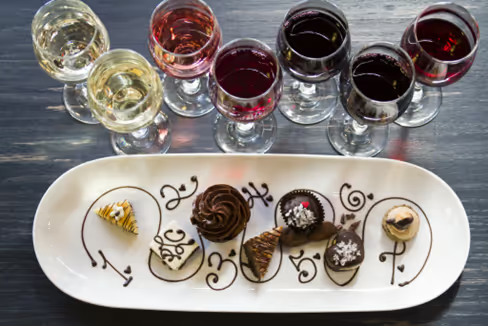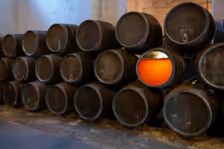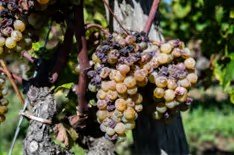Dessert Wines: A Reference Guide

Dessert wines are wines purposefully produced with varying amounts of residual sugar. While many of these are delicious on their own, and you can certainly pair most with more savory fare, particularly the spicy varieties, in today’s blog we are focused on the various dessert wines, where and how they are produced, and how to best pair which with your favorite desserts.

Categories of Dessert Wines
Fortified Wines:
These are wines that have spirits added to the grape must during fermentation before all of the sugar is consumed by the yeast. The spirit halts the fermentation process while the grapes are still sweet. These wines have the highest alcohol content of all the dessert wines, coming in at ~20% ABV. Some of these wines include:
● Port: Port is afortified wine from Portugal. It is made from indigenous red grapes, largely field blends that include Touriga Nacional and/or Touriga Franca. Port wines have a rich, fruity flavor with notes of chocolate, coffee, and spice.
Dessert Pairing: Chocolate desserts, Crème brûlée, almond tarts
● Sherry: Sherry is afortified wine from Jerez region of Andalucia, Spain. It is made from the indigenous white grapes, Palomino, Pedro Ximénez (PX), and/or Moscatel (Muscat), that are aged and blended using a system called Solera, which includes stacks of oak barrels. The primary sweet Sherry is Cream or Pale Cream Sherry, which pairs well with fruit tarts, nutty desserts, or pungent cheeses. Pedro Ximénez (PX) is a sweetening grape in sherries, but it is also produced on its own as a fantastic dessert wine.
Dessert Pairing: Chocolate, ice cream, caramel-based desserts
● Madeira: Madeira is afortified wine from the Madeira Islands of Portugal. It is made from indigenous grapes that include Tinta Negra, Malvasia, Boal, Verdelho, and Sercial, among others. This is one of the only wines in the world made with purposefully heating and/or oxidizing the grapes. Madeira has a variety of complex flavors and aromas depending on the grape.
There are primarily 2 sweet versions of Madeira. Boal (Bual), which has an average residual sugar content between 45-95 g/L and pairs well with chocolate, dried fruit, or caramel-based desserts. The sweetest Madeira is Malmsey (Malvasia) produced with anaverage residual content of >100 g/L.
Dessert Pairing: Ice cream, crème brûlée, and other rich desserts.
● Vin Doux Naturel (VDN): “Naturally Sweet Wines” are fortified dessert wines, largely produced in Southern France and Corsica from either the red Grenache grape or the white Muscat Blanc à Petit Grains varietal. Some key appellationsfor VDNs include Banyuls, Muscat de Beaumes-de-Venise, Muscat du CapCorse.
Dessert Pairing: Chocolate, ice cream, crème brûlée,and other rich desserts.
Some favorite fortified wines include:
2017 Dow's Vintage Porto - 98 Points
Alvear Pedro Ximénez Solera 1927 - 98 Points
Sandeman 20 Yr Tawny Port - 95 Points
Broadbent Madeira Colheita 1999 - 92 Points

Botrytis-Affected Wines:
These are wines that are made from grapes that are purposefully infected by the Botrytis Cinerea fungus, also known as “Noble Rot.” The fungus essentially raisinates the grapes, intensifying the sweetness level, adding amazing flavors, layers of complexity,and a much richer mouth feel. These canonly be produced in specific regions where the climate is just right for this particular fungus. Some of these wines include:
● Sauternes: Sauternes is aregion in Bordeaux producing some of the most coveted dessert wines in the world. These are made from Sémillon grapes that are sometimes blended with the other primary white grape of Bordeaux, Sauvignon Blanc.
○ Similar to the Sauternes sub-region of Bordeaux, the Coteau du Layon sub-region of the Loire Valley is also well-known for producing outstanding botrytis-affected wines, but from the Chenin Blanc grape. The wines from the only Grand Cru appellation in the region, Quartzde Charme, are notable, as are those from Bonnezeaux.
Dessert Pairing: Cheesecake, crème brûlée, lemon tart, meringues
● Selection deGrains Nobles (SGN) - These are “selection of noble berries” that are botrytis-affected wines made from the “noble grapes” of the Alsace region of France, which include Riesling, Pinot Gris, Gewürztraminer, and Muscat.
Dessert Pairing: Cheesecake, custard-based desserts, fruit pastries
● Tokaji Aszú: Tokaji is adessert wine from the Tokaji region of Hungary. It is made from Furmint grapesand aged in oak barrels. The sweetness levels are measured in Puttonyos. Essentially this refers to the number of baskets, known as puttony, full of botrytis-affected grapes that are added to the grape must. A 3 Puttonyo Tokaji has ~60g/L of sugar, while a 6 Puttonyo wine will have >160g/L.
○ Tokaji Eszencia is the sweetest wine in the world with an average residual sugar content of 450-600g/L. It is so rich and viscous that it can be served with a spoon. It also has the lowest alcohol content perhaps of all wines coming in at ~2.5% ABV
DessertPairing: Chocolate, fruit-based pastries, cheesecake, creme brûlée
● Beernauslese(BA) and Trockenbeerenauslese (TBA): These are at the top of the top tier - Prädikatswein - of the German wine quality pyramid and are highly coveted wines. These are late harvest wines, but also must be botrytis-affected to be rated BA or TBA. Riesling is the primary grape used in Germany, but in Austria, which has similar weather conditions and quality ratings to Germany, you will also find other varieties, notably Weissburgunder (Pinot Blanc), but also the red Zweigelt grape. These wines are sweet (>150 g/L residual sugar) to very sweet (>300g/L). The white varieties in particular impart flavors and aromas of apricots, peach, lychee, fig, melon, honey, cinnamon, and almonds.
Dessert Pairing: Caramel-based desserts, fruit-based desserts, pannetone
Some favorite botrytis-affected wines include:
2021 Château d'Yquem - 100 Points
2014 Château Climens1er Cru Barsac - 98 Points
2016 Disznókő Tokaji Aszú 6 Puttonyos - 97 Points
2019 Alois Kracher Trockenbeerenauslese No. 4 Zweigelt - 97 Points

Dessert Wines from Naturally Dried Grapes:
Making dessert wines from naturally dried grapes can be very time and labor intensive, but theresults are amazing. Grapes are handpicked and placed in small crates to avoid damage. They are then laid out on straw mats or hungfrom rafters for months in warm well-ventilated rooms to allow the moisturefrom the grape to evaporate and the sugars in the grapes to concentrate. The partially dehydrated grapes are thenpressed and fermented. The wine producedfrom this process is usually referred to as Passito(Italy), Vino de Pasa (Spain),and sometimes Straw Wine in differentparts of the world. Some of these winesinclude:
● Vin Santo: Vin Santo wines are millennia old,dating back to the Etruscan era when drying grapes post harvest was the onlymeans of making sweeter wines. InTuscany, Vin Santo is made from indigenous grapes, largely Trebbiano Toscanoand Malvasia Bianca Lunga for the more common white version, and Sangiovese forthe red version, called Occhio di Pernice. These are rich wines with flavors and aromasof dried fruits, hazelnut, caramel, honey, and apricots.
Dessert Pairing: Biscotti, tiramisu, cake, chocolate,pastries
● Recioto: Similar to Vin Santo, these wines are millennia old and highly coveted. This is a sweet red passito dessert wine made with the indigenous grapes of the Veneto region of Italy, primarily Corvina, Corvinone, and Rondinella. These wines impart flavors and aromas of ripeberries and cherries, figs, cinnamon, honey, and vanilla.
○ Reciotos made within the confines of the Valpolicella region are called Reciotodella Valpolicella and merit Italy’s highest wine quality classification, DOCG
Dessert Pairing: Chocolate, cakes, pastries, sweet fruit-based desserts
● Moscatel (Muscat of Alexandria): Moscatel is a dessert wine made from Muscatgrapes in Spain, mostly in the Málaga municipality of Andalucia. It is typically light and fruity, with notes of citrus, flowers, andhoney.
Dessert Pairing: Fruit-based desserts, icecream, pastries
● Vin de Constantia: a premier dessert wine made in the Western Cape region of South Africa from raisinated Muscat de Frontignan grapes (Muscat Blanc à Petit Grains). These impart flavors and aromas of apricots, marmalade, nutmeg, citrus, and jasmine.
Dessert Pairing: Fruit-based desserts and cakes, crème brûlée, sorbet
Some favorite dried grape dessert wines include:
2015 Badia a Coltibuono Vin Santo del Chianti Classico DOC - 96 Points
2015 Capezzana Vin Santo di Carmignano Riserva DOC - 96 Points
2023 Jorge Ordoñez Málaga No 2 Victoria - 94 Points

Late Harvest / Ice Wines:
Late harvest wines are just that, wines produced from grapes harvested as late as possible, when the sugar content is at its highest. Ice Wines (Eiswein in German) are harvested even later, usually after the first frost. The pressed grapes produce very little, but highly concentrated sweet juice. As ice wines are grown in cold climates, the grapes tend to retain high levels of acidity. The balance between the residual sugar and acidity creates wines with amazing flavors and great longevity. Many of these wines are highly coveted. Included in these are:
● Vendange Tardive (VT): French for “late harvest,” VT wines are most prominent from the Alsace region of France, where any of the noble grapes, notably Riesling, Pinot Gris, or Gewürztraminer, are harvested late when the grapes can produce wines with >200 g/L of residual sugar. Typical aromas and flavors of these wines include ripe stone fruits.
Dessert Pairing: Fruit-based desserts,meringues, ice cream
● Spätlese: German for “late harvest,” these wines have a wide range of sweetness levels. Perhaps the best of these are the Rieslings from Germany where German guidelines require residual sugar to be from 172-209g/L to be called a Spätlese. Even at these sweetness levels, the acidity can make these taste almost off-dry. These offer flavors and aromas of ripe pears, apricots, honey, candied lemon, ginger, ripe stone fruits, tangerine, and jasmine.
Dessert Pairing: Fruit-based desserts, caramel-based desserts, crème brûlée
● Late Harvest: Late Harvest wines are produced in just about every cold climate in the world. You can find outstanding Late Harvest Rieslings or the lesser known Vidal Blanc from Canada or New York, and delicious Muscats from Greece or Australia. There are a plethora of options.
Dessert Pairing: Cheesecake, chocolate, custard, fruit-baseddesserts
● Ice Wine (Eiswein in German): Icewines are grown in the coldest wine regions in the world, particularly in Canada’s Niagara Peninsula, the adjacent Finger Lakes of NewYork, or Germany’s Mosel region. The primary grapes are Riesling, Gewürztraminer, Grüner Veltliner, Cabernet Franc,and Vidal Blanc. These are very sweet with residual sugar content ranging from 180-320 g/L. These are also highly coveted for their richness and amazing flavors - pineapple, lemoncurd, honeysuckle, apricot, lychee.
Dessert Pairing: Cheesecake, ice cream, custards, fruit-based desserts
Some favorite dried grape dessert wines include:
2021 Joh Jos PrümWehlener Sonnenuhr Spätlese - 97 Points
2021 Inniskillin Riesling Icewine Niagara Peninsula - 96 Points
2022 Inniskillin Cabernet Franc Icewine Niagara Peninsula - 95 Points
There is also avery large variety of Sparkling dessert wines, including Moscato d’Asti or Asti Spumante, Demi-Sec Champagnes, Cremants, or other traditional method sparkling wines, Prosecco, Brachetto d’Aqui, Vernaccia di Serrapetrona, and many others. Please feel free to read about them in our Sommelier’s Guide to Sparkling Wines blog.
Sources for Additional Reading
Wine Scholar Guild, International Court of Sommeliers, Society of Wine Educators
Fine Wines and Unique Wine Collections and Curations
At Occasional Wine, we are passionate about wine and love sharing our knowledge with others so they too can enjoy the pleasures of an exceptional wine. The holidays are one of the best times to get to share that pleasure with family and friends, whether it’s giving the gift of wine or planning a big holiday dinner.
We offer three different tiers of biannual wine subscriptions, each with curated selections of six wines from six wine regions delivered each Spring and Fall to give you and yours samples of some of the best wines in theworld.
Enrollment in one of these wine club memberships also provides you with an exclusive discount that you can use on our private stock - a constantly updated selection of top-rated wines from around the world that can be purchased anytime!
Stay tuned for more helpful content in finding that next great wine for you, and as always feel free to contact us with any questions.

